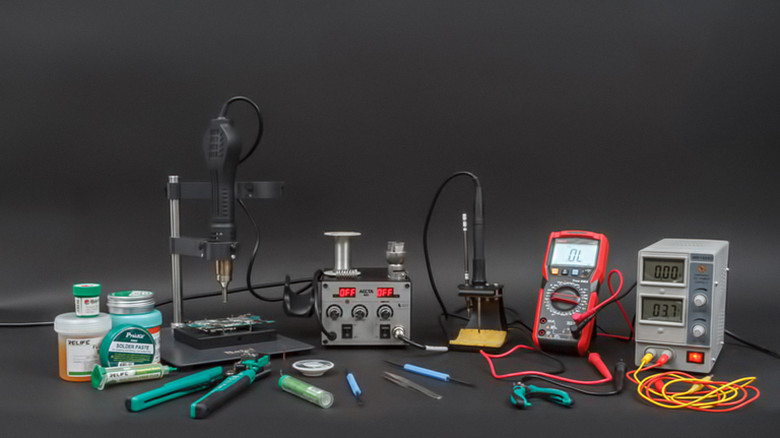Getting started with DIY electronics can be both exciting and overwhelming. Having the right tools is crucial for successfully completing your projects and ensuring safety while working with electronic components. This comprehensive guide for DIY electronics will walk you through the essential tools every electronics enthusiast should have in their workspace.
Top Essential Tools for DIY Electronics
1. Multimeter
A digital multimeter is perhaps the most important tool in your electronics toolkit. It measures voltage, current, and resistance, helping you troubleshoot circuits and verify component values. Look for one with continuity testing and capacitance measurement features.
2. Soldering Iron and Solder
A temperature-controlled soldering iron is essential for connecting components. Choose one with adjustable temperature settings (around 300-400°C) and different tip options. A good starting wattage is between 30-60 watts for most electronics work.
3. Wire Strippers
Quality wire strippers allow you to safely remove insulation from wires without damaging the conductors. Look for ones with multiple gauge settings and comfortable grips. Some models include crimping capabilities as an added bonus.
4. Needle-nose Pliers
These pliers are perfect for bending leads, holding small components, and reaching into tight spaces. Their precise tips make them invaluable for detailed work with electronic components.
5. Side Cutters
Also known as diagonal cutters, these tools are used for trimming component leads and cutting wires. Choose a pair with sharp edges and spring-loaded handles for comfortable use during long projects.
6. Anti-static Mat and Wrist Strap
These protect sensitive electronic components from static electricity damage. The mat provides a safe work surface, while the wrist strap grounds you to prevent static buildup.
7. Magnifying Glass or Loupe
Essential for inspecting solder joints, reading tiny component values, and examining PCB traces. A illuminated magnifying glass with 3x to 10x magnification is ideal.
8. Tweezers
Anti-static tweezers help manipulate small components and hold parts in place while soldering. Get a set with both straight and curved tips for different applications.
9. Helping Hands
This tool holds circuit boards and components steady while you work. Models with flexible arms and magnifying glasses are particularly useful for detailed soldering work.
10. Storage Solutions
Organize components with compartmentalized boxes and anti-static bags. Proper storage prevents loss and damage while keeping your workspace efficient.
FAQs About Essential Tools for DIY Electronics
1. What should be my first investment in electronics tools?
Start with a quality digital multimeter and basic soldering iron. These two tools will enable you to complete many beginner projects while learning fundamental skills.
2. How much should I expect to spend on a basic electronics toolkit?
A basic but quality toolkit including a multimeter, soldering iron, and essential hand tools typically costs between $100-200. You can expand your collection as needed for specific projects.
3. Do I need special tools for working with surface-mount components (SMD)?
Yes, SMD work requires additional tools like fine-tipped tweezers, a hot air rework station, and a good magnification system. However, beginners should start with through-hole components before moving to SMD.
4. How often should I replace soldering iron tips?
Replace tips when they show signs of pitting, oxidation, or won’t hold solder properly. With proper care and regular cleaning, a good tip can last 6-12 months of regular use.
5. Is it worth investing in a temperature-controlled soldering station?
Yes, temperature control is crucial for protecting sensitive components and achieving consistent results. While more expensive initially, it’s a worthwhile investment for serious hobbyists.
6. What safety equipment do I need?
Essential safety items include safety glasses, a fire-resistant work surface, proper ventilation or fume extraction, and a first aid kit. Never compromise on safety equipment.
7. Can I use regular pliers instead of needle-nose pliers?
While regular pliers can work in some situations, needle-nose pliers offer better precision and access to tight spaces, making them essential for electronics work.
8. How do I maintain my electronic tools?
Clean tools regularly, store them in a dry place, and calibrate measuring instruments periodically. Keep soldering iron tips tinned and clean between uses.
9. What’s the difference between cheap and expensive multimeters?
More expensive multimeters typically offer better accuracy, durability, safety features, and measurement ranges. For hobbyist use, a mid-range meter is usually sufficient.
10. Should I buy a tool kit or individual tools?
While pre-made kits can offer good value, buying individual tools allows you to choose quality items that meet your specific needs. Consider starting with a basic kit and upgrading individual tools as needed.
Conclusion
Building your electronics toolkit is an investment in your hobby or profession. While it might seem expensive initially, quality tools will last longer, perform better, and make your projects more enjoyable. Start with the basics and expand your collection as your skills and project requirements grow. Remember that safety should always be your primary concern when selecting and using electronics tools. With the right tools and proper knowledge, you’ll be well-equipped to tackle a wide range of electronics projects.
